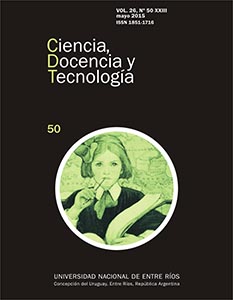Abstract
As part of a general study on teachers and students of Technology from the approach of Social Representations (SR), making an initial focus on the difficulties related to teaching and learning that discipline, we offered a space for reflection on this topic for teachers of secondary schools and carried out a series of activities, among them an inquiry about the SR of their students. In this paper, we present the results from the analysis of Technology SR –identified in the students-, teaching and learning, done by implementation of two Likert scales and a technique of evocation and hierarchy. The results obtained have allowed us to identify the students’ SR and to try to infer a relationship with teaching practices. The need for teachers to know their students’ SR in order to optimize their educational practice seems evident.
References
ABRIC, J.C. (2001). Prácticas sociales y representaciones. México: Coyoacán.
BIXIO, C. (2005). Enseñar a aprender. Construir un espacio colectivo de enseñanza-aprendizaje. Rosario. Santa Fe: Homo Sapiens Ediciones.
CERVERA, D. (2010). Didáctica de la tecnología (Vol. 2). Barcelona: Grao.
FARR, R. (2003). De las representaciones colectivas a las representaciones sociales: ida y vuelta (pp. 153 -175). En CASTORINA, J. (comp.), Representaciones Sociales. Problemas teóricos y conocimientos infantiles. Barcelona: Gedisa.
GILBERT, J. K. (1995). Educación tecnológica: una nueva asignatura en todo el mundo. Enseñanza de las Ciencias, 13(1): 15-24.
GILBERT, J. K., BOULTER, C. J. y ELMER, R. (2000). Positioning Models in Science Education and in Design and Technology Education, (pp. 3-18). En GILBERT, J. K y BOULTER, C. J. (eds), Developing Models in Science Education, Dordrecht: Kluwer.
GUIRADO, A.; MAZZITELLI, C. y OLIVERA, A. (2013). Representaciones sociales y práctica docente: una experiencia con profesores de Física y de Química. Revista Orientación Educacional, 27 (51): 1-20.
JODELET, D. (1986). La Representación social: fenómenos, concepto y teoría, (pp. 470-494). En MOSCOVICI, S. (comp.) Psicología Social (Vol. 1). Barcelona: Paidós.
KAPLAN, C. (1997). La inteligencia escolarizada. Un estudio de las representaciones sociales de los maestros sobre la inteligencia de los alumnos y su eficacia simbólica. Buenos Aires: Miño y Dávila.
MARCELO, C. (2009). Formalidad e informalidad en el proceso de aprender a enseñar. Revista de Educación, 350: 31-56.
MAZZITELLI, C. (2007/2009). El aprendizaje de la Física como reelaboración conceptual a la luz de algunas teorías psicosociales. San Juan – Argentina: Editorial de la Facultad de Filosofía, Humanidades y Artes – UNSJ.
MAZZITELLI, C. y APARICIO, M. (2009). Las actitudes de los alumnos hacia las Ciencias Naturales, en el marco de las representaciones sociales, y su influencia en el aprendizaje. Revista Electrónica de Enseñanza de las Ciencias, 8 (1), Artículo 11, En: http://www.saum.uvigo.es/reec.
MAZZITELLI, C., AGUILAR, S., GUIRADO, A. y OLIVERA, A. (2009). Representaciones sociales de los profesores sobre la docencia: contenido y estructura. Revista Educación, Lectura y Sociedad, 6 (6): 265-290.
MOSCOVICI, S. (1986). Psicología social, I. Barcelona-España: Paidós.
PETRACCI, M. y KORNBLIT, A. (2007). Representaciones sociales: una teoría metodológicamente pluralista, (pp. 91-111). En KORNBLIT, A. (comp.), Metodologías cualitativas en Ciencias Sociales. Buenos Aires: Biblos.
ROMERO JELDRES, M. (2009). Didáctica de la Educación Tecnológica: hacia un modelo explicativo-cultural para el aprendizaje de la tecnología. Tecné, Episteme y Didaxis, 26: 36-52.
The authors retain the copyright and grant the journal the right to be the first publication of the work, as well as licensing it under a Creative Commons Attribution License that allows others to share the work with an acknowledgment of the authorship of the work and publication initial in this magazine. All content is published under the Creative Commons 4.0 international license: Attribution-Non-Commercial-Share Alike.

